The Cambridge History of China. Vol. 13: Republican China 1912-1949, Part 2
Подождите немного. Документ загружается.


THE MIDDLE YEARS 1939-1943 691
What had been praiseworthy in Shanghai during the early 1930s,
however,
was
unacceptable in Yenan
a
decade
later.
These intellectuals must
have felt they were taking a risk, but they could hardly have anticipated
the severity of the party's response. All of them were severely criticized
and made to recant, though most were eventually rehabilitated. Wang
Shih-wei, less prominent and more corrosive than most, was repeatedly
attacked in mass meetings, discredited, jailed, and secretly executed in 1947.
If
his
February addresses and other party directives had failed properly
to educate the intellectuals, Mao was ready to go further. He took these
steps in May 1942, in the lengthy 'Talks at the Yenan Forum on art and
literature'. Here he laid down, in explicit detail, the role of intellectuals
under the leadership of the Chinese Communist Party. This statement
remained authoritative throughout Mao's lifetime, and continues after his
death to exert its influence. In
brief,
' Talks' denies the independence and
autonomy of the mind, apart from social class. One can only speak or
write from a class standpoint; intellectuals are quite wrong to think that
there is some objectively neutral ground upon which they can stand. Since
this is so, art is one form of politics and the question then becomes
which
class it will represent. Revolutionary intellectuals must take their stand
with the proletariat for otherwise they serve the bourgeoisie or other
reactionary classes, even when they deny they are doing so. It follows that
the ultimate arbiter and guide for literature and art is the Chinese
Communist Party (led by Mao Tse-tung), since this is the vanguard, the
concentrated will, of the working classes.
Mao thus turned the tables on the intellectuals: no longer independent
critics, they were now the targets of criticism. So long as intellectuals were
willing to play the role of handmaidens to the revolution, as defined by
the CCP, they were needed and welcomed. There was no denying their
creativity and their skills, but these talents were to be valued only within
the limits set by the party. Socialist realism was to be the major mode
of literature and art, given naturalistic Chinese forms that would be at
once accessible to the masses and expressed in their own idiom, not that
of Shanghai salons. This meant that intellectuals had to go among the
peasants and workers, absorb their language and experience the harsh
realities of their lives. Altogether, Mao was calling for the transformation
of party intellectuals and of party members more generally.
By April
1942,
the Central Committee had published a list of twenty-two
documents to serve as the basis of cadre study and examination.
98
The
°
8
Sec Compton, 6-7. The list contained six items by Mao; five Central Committee documents
(probably authored in whole or in pan by
Mao);
one each by Liu Shao-ch'i, Ch'en Yun and K'ang
Sheng; a propaganda guide; an army report; three by Stalin; one by Lenin and Stalin; one by
Cambridge Histories Online © Cambridge University Press, 2008
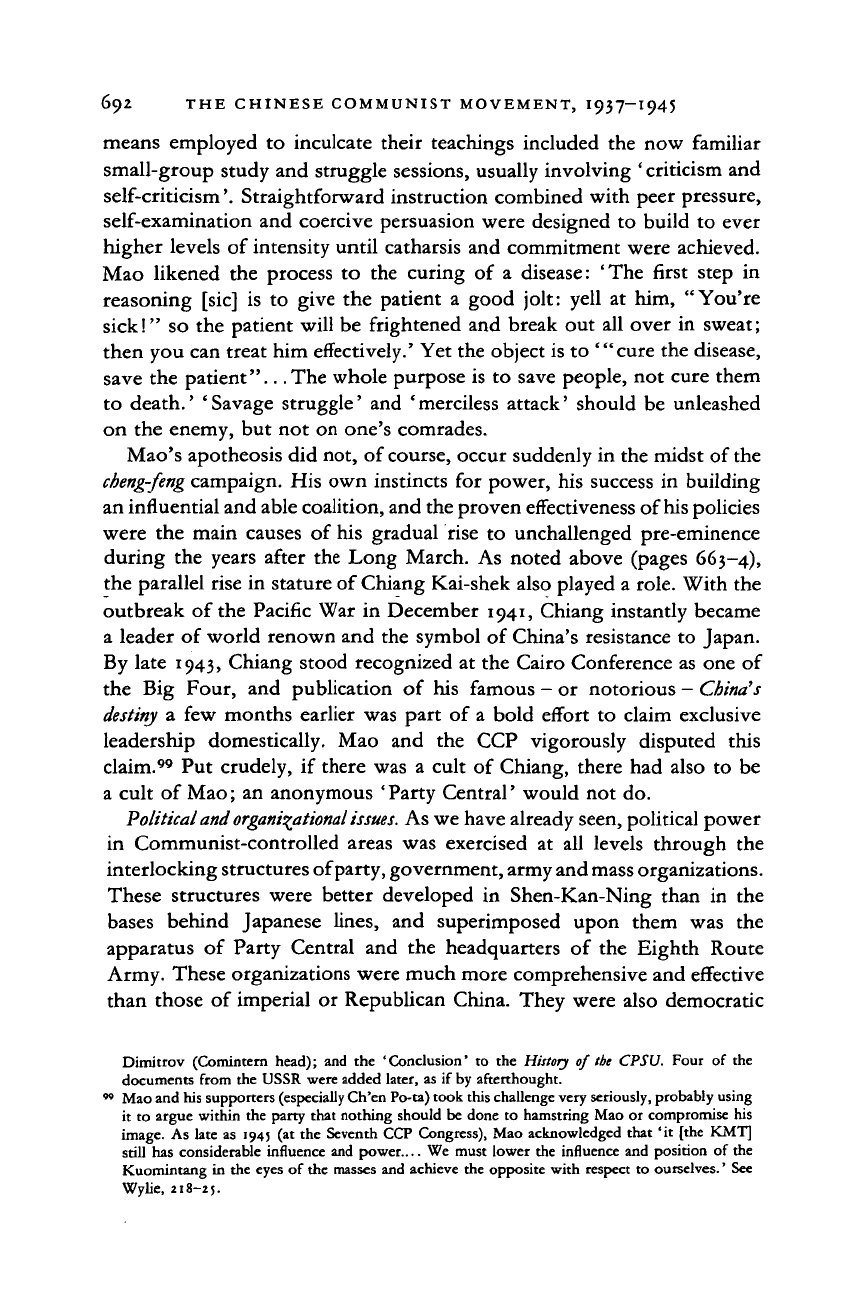
692 THE CHINESE COMMUNIST MOVEMENT, I937—1945
means employed
to
inculcate their teachings included the now familiar
small-group study and struggle sessions, usually involving ' criticism and
self-criticism'. Straightforward instruction combined with peer pressure,
self-examination and coercive persuasion were designed
to
build
to
ever
higher levels
of
intensity until catharsis and commitment were achieved.
Mao likened
the
process
to the
curing
of a
disease: 'The first step
in
reasoning [sic]
is to
give the patient
a
good jolt: yell
at
him, "You're
sick!" so the patient will be frightened and break out all over in sweat;
then you can treat him effectively.' Yet the object is to '"cure the disease,
save the patient".. .The whole purpose is
to
save people, not cure them
to death.' 'Savage struggle' and 'merciless attack' should
be
unleashed
on the enemy, but not on one's comrades.
Mao's apotheosis did not, of
course,
occur suddenly in the midst of the
cheng-feng
campaign. His own instincts for power, his success
in
building
an influential and able coalition, and the proven effectiveness of his policies
were the main causes
of
his gradual rise
to
unchallenged pre-eminence
during the years after the Long March. As noted above (pages 663-4),
the parallel rise in stature of Chiang Kai-shek also played a role. With the
outbreak of the Pacific War
in
December 1941, Chiang instantly became
a leader of world renown and the symbol
of
China's resistance to Japan.
By late 1943, Chiang stood recognized at the Cairo Conference as one of
the
Big
Four,
and
publication
of
his famous
-
or notorious
-
China's
destiny
a
few months earlier was part
of
a bold effort
to
claim exclusive
leadership domestically.
Mao and the
CCP vigorously disputed this
claim." Put crudely,
if
there was
a
cult
of
Chiang, there had also
to be
a cult
of
Mao; an anonymous
'
Party Central' would not do.
Political and organisational
issues.
As we have already seen, political power
in Communist-controlled areas was exercised
at all
levels through
the
interlocking structures of party, government, army and mass organizations.
These structures were better developed
in
Shen-Kan-Ning than
in the
bases behind Japanese lines,
and
superimposed upon them
was the
apparatus
of
Party Central
and the
headquarters
of
the Eighth Route
Army. These organizations were much more comprehensive and effective
than those
of
imperial or Republican China. They were also democratic
Dimitrov (Comintern head);
and the
'Conclusion'
to the
History
of
the
CPSU.
Four
of
the
documents from the USSR were added later, as
if
by afterthought.
Mao and his supporters (especially Ch'en Po-ta) took this challenge very seriously, probably using
it
to
argue within the party that nothing should be done
to
hamstring Mao
or
compromise his
image. As late as 1945 (at the Seventh CCP Congress), Mao acknowledged that
'it
[the KMT]
still has considerable influence and power We must lower the influence and position
of
the
Kuomintang
in
the eyes
of
the masses and achieve the opposite with respect
to
ourselves.' See
Wylie, 218-25.
Cambridge Histories Online © Cambridge University Press, 2008
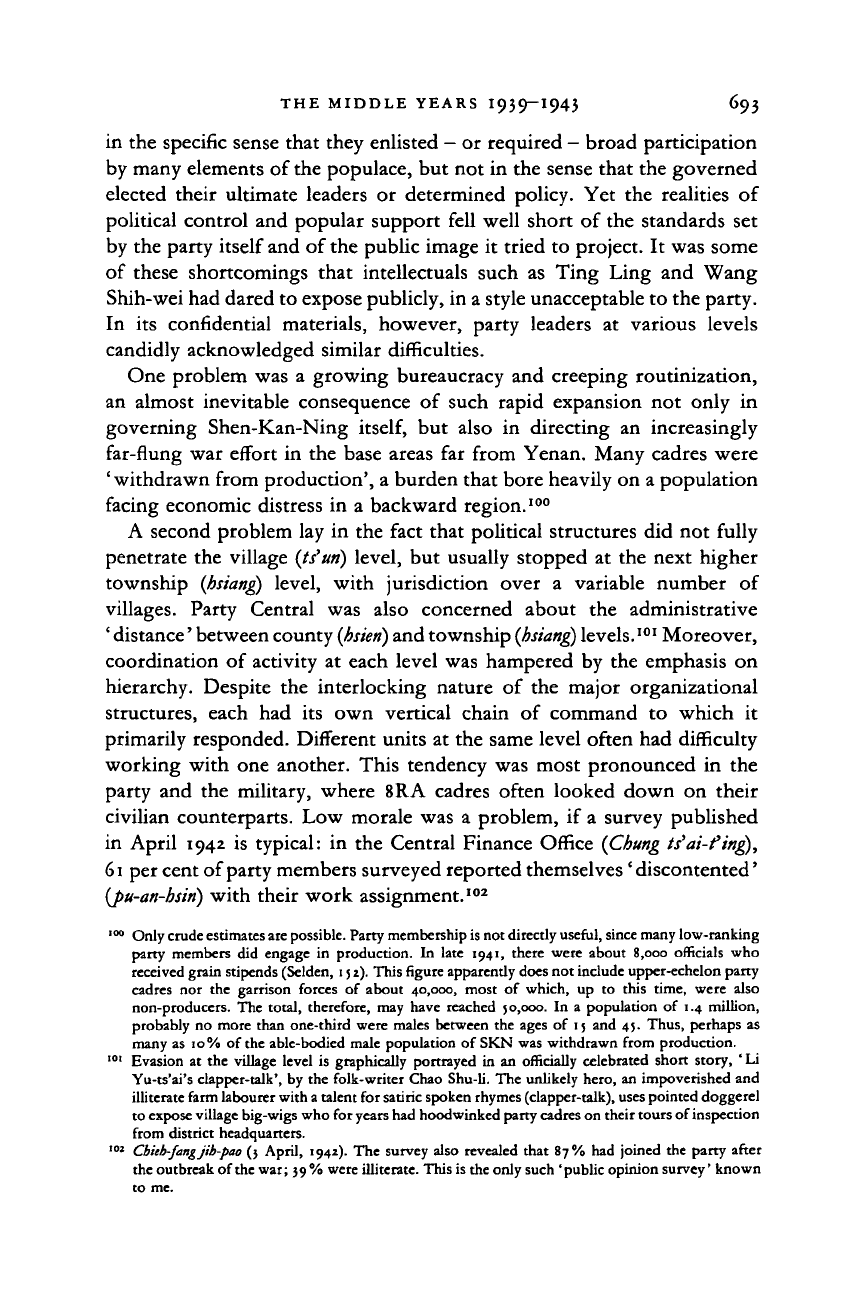
THE MIDDLE YEARS I939—1943 693
in the specific sense that they enlisted
—
or required
—
broad participation
by many elements of the populace, but not in the sense that the governed
elected their ultimate leaders or determined policy. Yet the realities of
political control and popular support fell well short of the standards set
by the party itself and of the public image it tried to project. It was some
of these shortcomings that intellectuals such as Ting Ling and Wang
Shih-wei had dared to expose publicly, in a style unacceptable to the party.
In its confidential materials, however, party leaders at various levels
candidly acknowledged similar difficulties.
One problem was a growing bureaucracy and creeping routinization,
an almost inevitable consequence of such rapid expansion not only in
governing Shen-Kan-Ning
itself,
but also in directing an increasingly
far-flung war effort in the base areas far from Yenan. Many cadres were
' withdrawn from production', a burden that bore heavily on a population
facing economic distress in a backward region.
100
A second problem lay in the fact that political structures did not fully
penetrate the village (ts'un) level, but usually stopped at the next higher
township
(bsiang)
level, with jurisdiction over a variable number of
villages. Party Central was also concerned about the administrative
' distance' between county
(hsieri)
and township
(bsiang)
levels.
I01
Moreover,
coordination of activity at each level was hampered by the emphasis on
hierarchy. Despite the interlocking nature of the major organizational
structures, each had its own vertical chain of command to which it
primarily responded. Different units at the same level often had difficulty
working with one another. This tendency was most pronounced in the
party and the military, where 8RA cadres often looked down on their
civilian counterparts. Low morale was a problem, if a survey published
in April 1942 is typical: in the Central Finance Office
{Chung
tiai-fing),
61 per cent of party members surveyed reported themselves' discontented'
{pu-an-hsiti)
with their work assignment.
102
100
Only crude estimates are possible. Party membership is not directly useful, since many low-ranking
party members
did
engage
in
production.
In
late 1941, there were about
8,000
officials
who
received grain stipends (Selden,
1
j 1). This figure apparently does not include upper-echelon party
cadres
nor the
garrison forces
of
about 40,000, most
of
which,
up to
this time, were also
non-producers.
The
total, therefore,
may
have reached 50,000.
In a
population
of 1.4
million,
probably
no
more than one-third were males between
the
ages
of
15
and
45. Thus, perhaps
as
many
as
10%
of
the able-bodied male population
of
SKN was withdrawn from production.
101
Evasion
at the
village level
is
graphically portrayed
in an
officially celebrated short story,
'Li
Yu-ts'ai's clapper-talk',
by the
folk-writer Chao Shu-li. The unlikely hero,
an
impoverished and
illiterate farm labourer with a talent for satiric spoken rhymes (clapper-talk), uses pointed doggerel
to expose village big-wigs who for years had hoodwinked party cadres on their tours of inspection
from district headquarters.
102
Chieb-fangjib-pao
(3
April, 1941).
The
survey also revealed that 87%
had
joined
the
party after
the outbreak of the war; 39% were illiterate. This is the only such
'
public opinion survey' known
Cambridge Histories Online © Cambridge University Press, 2008
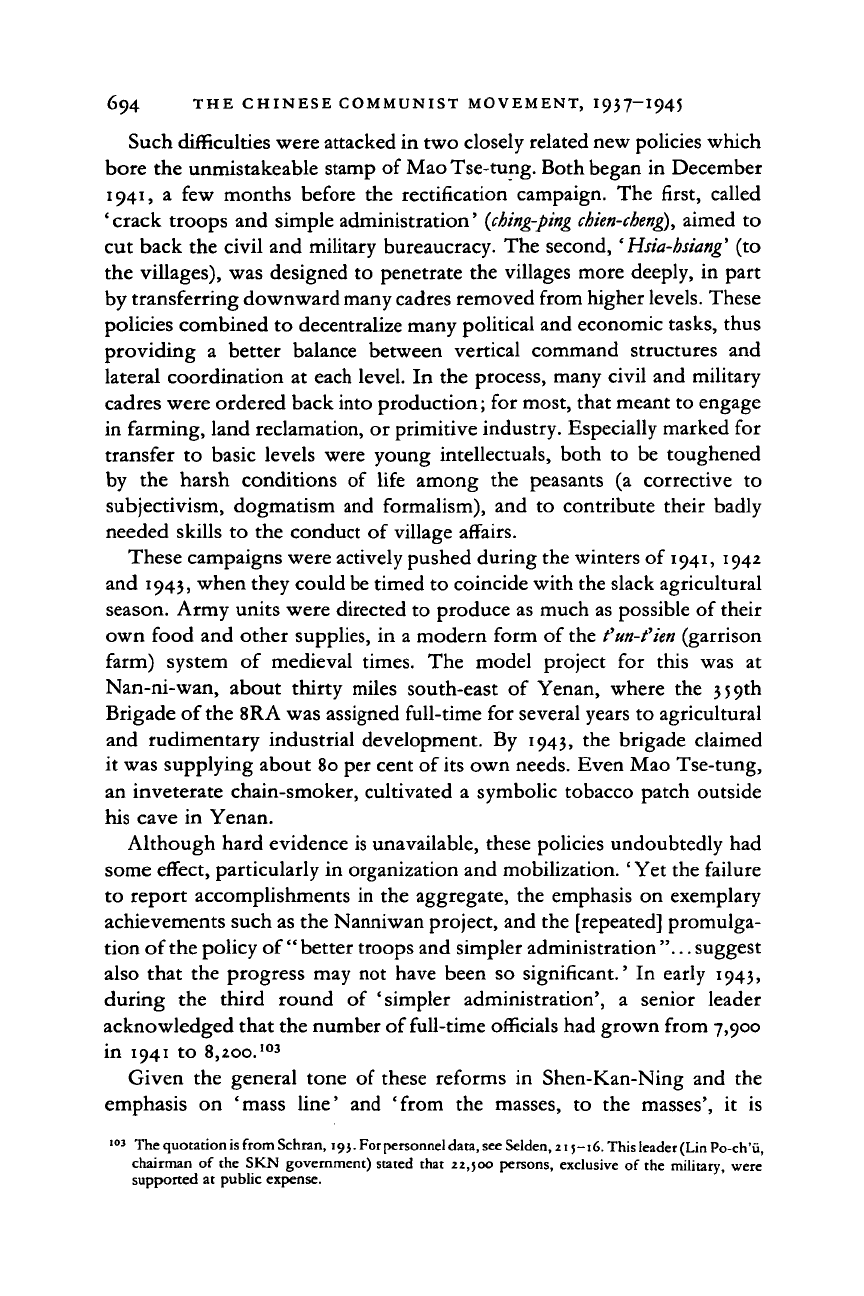
694
THE
CHINESE COMMUNIST MOVEMENT, I937-I945
Such difficulties were attacked
in
two closely related new policies which
bore
the
unmistakeable stamp
of
Mao
Tse-tung.
Both began
in
December
1941,
a few
months before
the
rectification campaign.
The
first, called
' crack troops
and
simple administration'
{ching-ping
chien-cheng),
aimed
to
cut back
the
civil
and
military bureaucracy.
The
second,
'
Hsia-bsiang'
(to
the villages),
was
designed
to
penetrate
the
villages more deeply,
in
part
by transferring downward many cadres removed from higher
levels.
These
policies combined
to
decentralize many political and economic tasks, thus
providing
a
better balance between vertical command structures
and
lateral coordination
at
each level.
In the
process, many civil
and
military
cadres were ordered back into production;
for
most, that meant
to
engage
in farming, land reclamation,
or
primitive industry. Especially marked
for
transfer
to
basic levels were young intellectuals, both
to be
toughened
by
the
harsh conditions
of
life among
the
peasants
(a
corrective
to
subjectivism, dogmatism
and
formalism),
and to
contribute their badly
needed skills
to the
conduct
of
village affairs.
These campaigns were actively pushed during the winters
of
1941,
1942
and 1943, when they could be timed
to
coincide with the slack agricultural
season. Army units were directed
to
produce as much
as
possible
of
their
own food
and
other supplies,
in a
modern form
of
the fun-fien (garrison
farm) system
of
medieval times.
The
model project
for
this
was at
Nan-ni-wan, about thirty miles south-east
of
Yenan, where
the
359th
Brigade
of
the 8RA was assigned full-time
for
several years
to
agricultural
and rudimentary industrial development.
By
1943,
the
brigade claimed
it was supplying about 80 per cent
of
its own needs. Even Mao Tse-tung,
an inveterate chain-smoker, cultivated
a
symbolic tobacco patch outside
his cave
in
Yenan.
Although hard evidence is unavailable, these policies undoubtedly
had
some effect, particularly
in
organization and mobilization. ' Yet the failure
to report accomplishments
in the
aggregate,
the
emphasis
on
exemplary
achievements such as the Nanniwan project, and the [repeated] promulga-
tion of the policy
of "
better troops and simpler administration "... suggest
also that
the
progress
may not
have been
so
significant.'
In
early
1943,
during
the
third round
of
'simpler administration',
a
senior leader
acknowledged that the number
of
full-time officials had grown from 7,900
in 1941 to
8,200.
103
Given
the
general tone
of
these reforms
in
Shen-Kan-Ning
and the
emphasis
on
'mass line'
and
'from
the
masses,
to the
masses',
it is
103
The quotation is from Schran,
193.
For personnel
data,
see Selden, 215-16. This
leader (Lin
Po-ch'ii,
chairman
of
the
SKN
government) stated that 22,500 persons, exclusive
of
the military, were
supported
at
public expense.
Cambridge Histories Online © Cambridge University Press, 2008
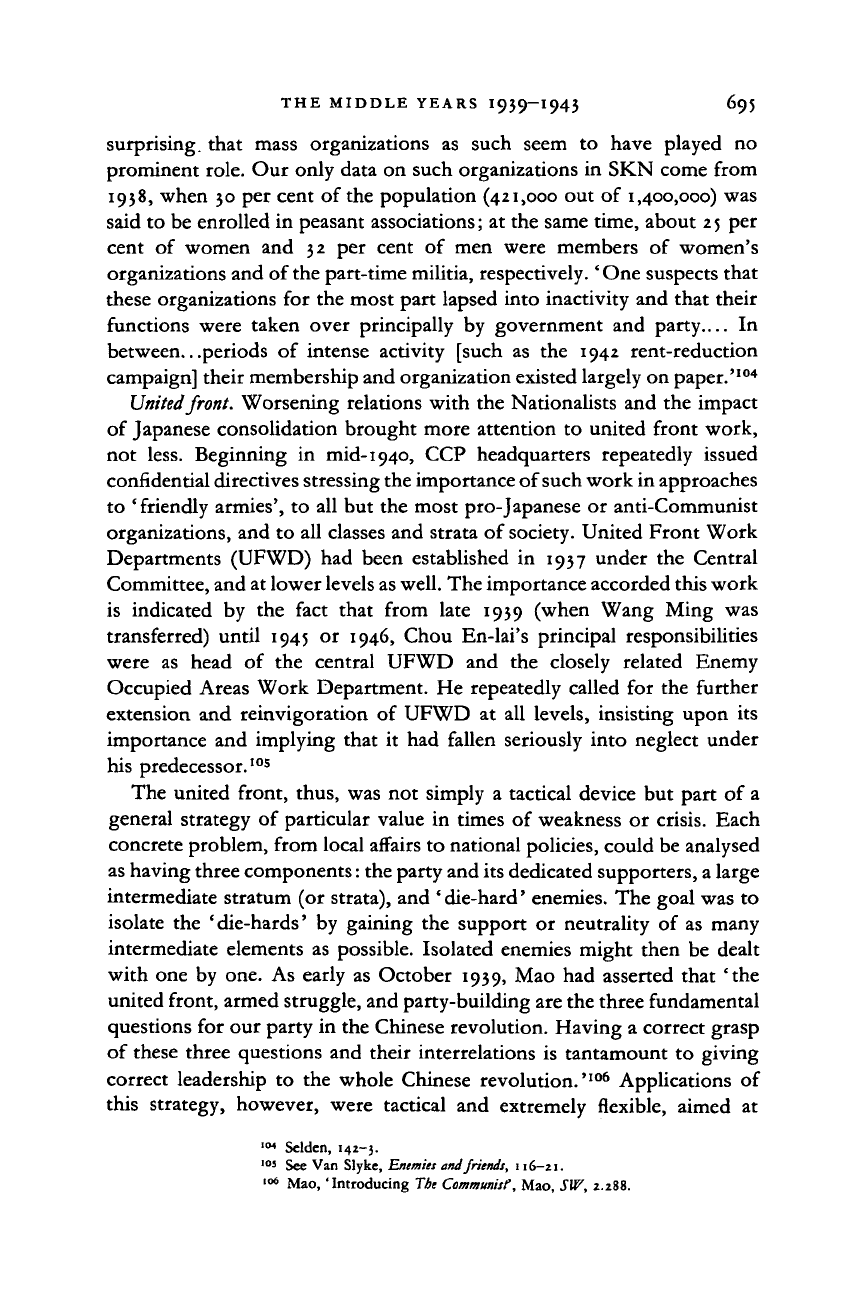
THE MIDDLE YEARS I939-I943 695
surprising, that mass organizations as such seem to have played no
prominent role. Our only data on such organizations in SKN come from
1938,
when 30 per cent of the population (421,000 out of
1,400,000)
was
said to be enrolled in peasant associations; at the same time, about 25 per
cent of women and 32 per cent of men were members of women's
organizations and of
the
part-time militia, respectively.' One suspects that
these organizations for the most part lapsed into inactivity and that their
functions were taken over principally by government and party In
between.. .periods of intense activity [such as the 1942 rent-reduction
campaign] their membership and organization existed largely on paper.'
104
United front. Worsening relations with the Nationalists and the impact
of Japanese consolidation brought more attention to united front work,
not less. Beginning in mid-1940, CCP headquarters repeatedly issued
confidential directives stressing the importance of such work in approaches
to ' friendly armies', to all but the most pro-Japanese or anti-Communist
organizations, and to all classes and strata of society. United Front Work
Departments (UFWD) had been established in 1937 under the Central
Committee, and at lower levels as well. The importance accorded this work
is indicated by the fact that from late 1939 (when Wang Ming was
transferred) until 1945 or 1946, Chou En-lai's principal responsibilities
were as head of the central UFWD and the closely related Enemy
Occupied Areas Work Department. He repeatedly called for the further
extension and reinvigoration of UFWD at all levels, insisting upon its
importance and implying that it had fallen seriously into neglect under
his predecessor.
105
The united front, thus, was not simply a tactical device but part of a
general strategy of particular value in times of weakness or crisis. Each
concrete problem, from local affairs to national policies, could be analysed
as having three components: the party and its dedicated supporters, a large
intermediate stratum (or strata), and ' die-hard' enemies. The goal was to
isolate the 'die-hards' by gaining the support or neutrality of as many
intermediate elements as possible. Isolated enemies might then be dealt
with one by one. As early as October 1939, Mao had asserted that 'the
united front, armed struggle, and party-building are the three fundamental
questions for our party in the Chinese revolution. Having a correct grasp
of these three questions and their interrelations is tantamount to giving
correct leadership to the whole Chinese revolution.'
106
Applications of
this strategy, however, were tactical and extremely flexible, aimed at
•« Selden, 142-3.
103
See Van Slyke, Enemies ami friends, 116-21.
106
Mao, 'Introducing The
Communisf,
Mao, SW, 2.288.
Cambridge Histories Online © Cambridge University Press, 2008
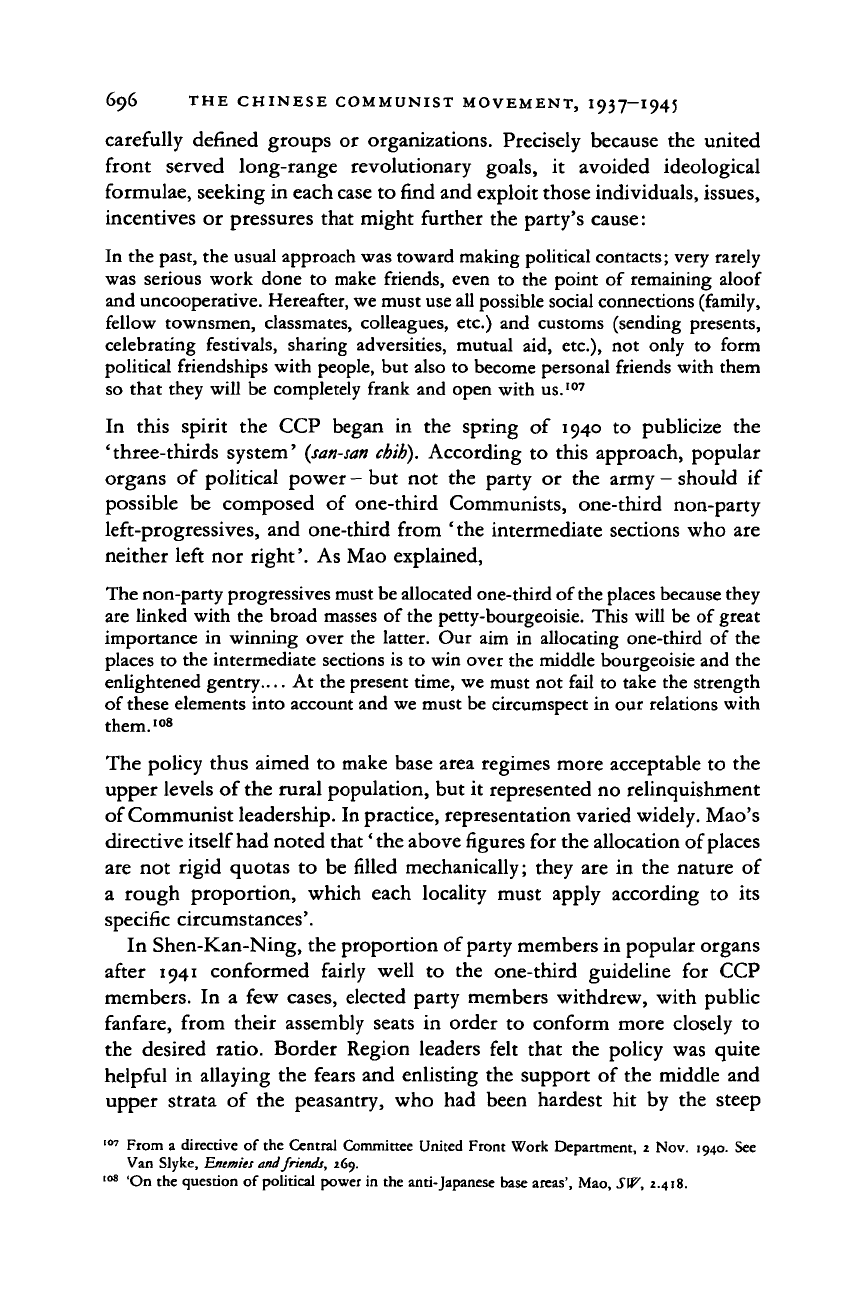
696 THE CHINESE COMMUNIST MOVEMENT, I937-I945
carefully defined groups
or
organizations. Precisely because the united
front served long-range revolutionary goals,
it
avoided ideological
formulae, seeking in each case to find and exploit those individuals, issues,
incentives or pressures that might further the party's cause:
In the past, the usual approach was toward making political contacts; very rarely
was serious work done to make friends, even to the point of remaining aloof
and uncooperative. Hereafter, we must
use
all possible social connections (family,
fellow townsmen, classmates, colleagues, etc.) and customs (sending presents,
celebrating festivals, sharing adversities, mutual aid, etc.), not only
to
form
political friendships with people, but also to become personal friends with them
so that they will be completely frank and open with
us.
107
In this spirit
the
CCP began
in the
spring
of
1940
to
publicize
the
'three-thirds system'
(san-san
chib).
According
to
this approach, popular
organs
of
political power
-
but not the party
or
the army
-
should
if
possible
be
composed
of
one-third Communists, one-third non-party
left-progressives, and one-third from 'the intermediate sections who are
neither left nor right'. As Mao explained,
The non-party progressives must
be
allocated one-third of the places because they
are linked with the broad masses of the petty-bourgeoisie. This will be of great
importance in winning over the latter. Our aim in allocating one-third of the
places to the intermediate sections is to win over the middle bourgeoisie and the
enlightened gentry At the present time, we must not fail to take the strength
of
these
elements into account and we must be circumspect in our relations with
them.
108
The policy thus aimed to make base area regimes more acceptable to the
upper levels of the rural population, but it represented no relinquishment
of Communist leadership. In practice, representation varied widely. Mao's
directive itself had noted that 'the above figures for the allocation of places
are not rigid quotas
to
be filled mechanically; they are
in
the nature of
a rough proportion, which each locality must apply according
to its
specific circumstances'.
In Shen-Kan-Ning, the proportion of party members in popular organs
after 1941 conformed fairly well
to the
one-third guideline
for
CCP
members.
In a
few cases, elected party members withdrew, with public
fanfare, from their assembly seats
in
order
to
conform more closely
to
the desired ratio. Border Region leaders felt that the policy was quite
helpful in allaying the fears and enlisting the support of the middle and
upper strata
of
the peasantry, who had been hardest
hit by
the steep
107
From
a
directive
of
the Central Committee United Front Work Department, 2 Nov. 1940. See
Van Slyke, Enemies and friends, 269.
108
'On the question of political power in the anti-Japanese base areas', Mao, SW, 2.418.
Cambridge Histories Online © Cambridge University Press, 2008
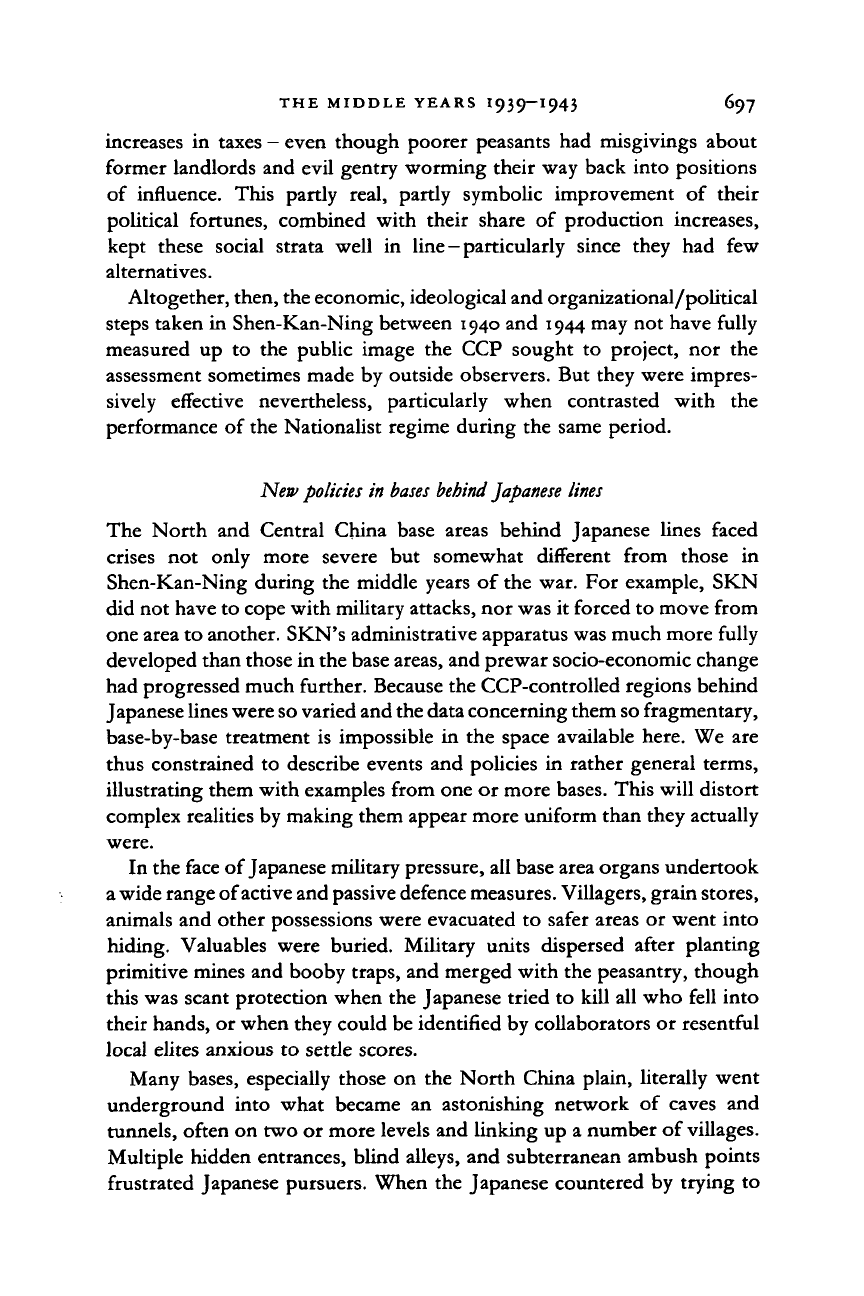
THE MIDDLE YEARS 1939-1943 697
increases in taxes
—
even though poorer peasants had misgivings about
former landlords and evil gentry worming their way back into positions
of influence. This partly real, partly symbolic improvement of their
political fortunes, combined with their share of production increases,
kept these social strata well in line —particularly since they had few
alternatives.
Altogether, then, the economic, ideological and organizational/political
steps taken in Shen-Kan-Ning between 1940 and 1944 may not have fully
measured up to the public image the CCP sought to project, nor the
assessment sometimes made by outside observers. But they were impres-
sively effective nevertheless, particularly when contrasted with the
performance of the Nationalist regime during the same period.
New
policies
in
bases behind Japanese
lines
The North and Central China base areas behind Japanese lines faced
crises not only more severe but somewhat different from those in
Shen-Kan-Ning during the middle years of the war. For example, SKN
did not have to cope with military attacks, nor was it forced to move from
one area to another. SKN's administrative apparatus was much more fully
developed than those in the base areas, and prewar socio-economic change
had progressed much further. Because the CCP-controlled regions behind
Japanese lines were so varied and the data concerning them so fragmentary,
base-by-base treatment is impossible in the space available here. We are
thus constrained to describe events and policies in rather general terms,
illustrating them with examples from one or more bases. This will distort
complex realities by making them appear more uniform than they actually
were.
In the face of Japanese military pressure, all base area organs undertook
a wide range of active and passive defence
measures.
Villagers, grain stores,
animals and other possessions were evacuated to safer areas or went into
hiding. Valuables were buried. Military units dispersed after planting
primitive mines and booby traps, and merged with the peasantry, though
this was scant protection when the Japanese tried to kill all who fell into
their hands, or when they could be identified by collaborators or resentful
local elites anxious to settle scores.
Many bases, especially those on the North China plain, literally went
underground into what became an astonishing network of caves and
tunnels, often on two or more levels and linking up a number of villages.
Multiple hidden entrances, blind alleys, and subterranean ambush points
frustrated Japanese pursuers. When the Japanese countered by trying to
Cambridge Histories Online © Cambridge University Press, 2008
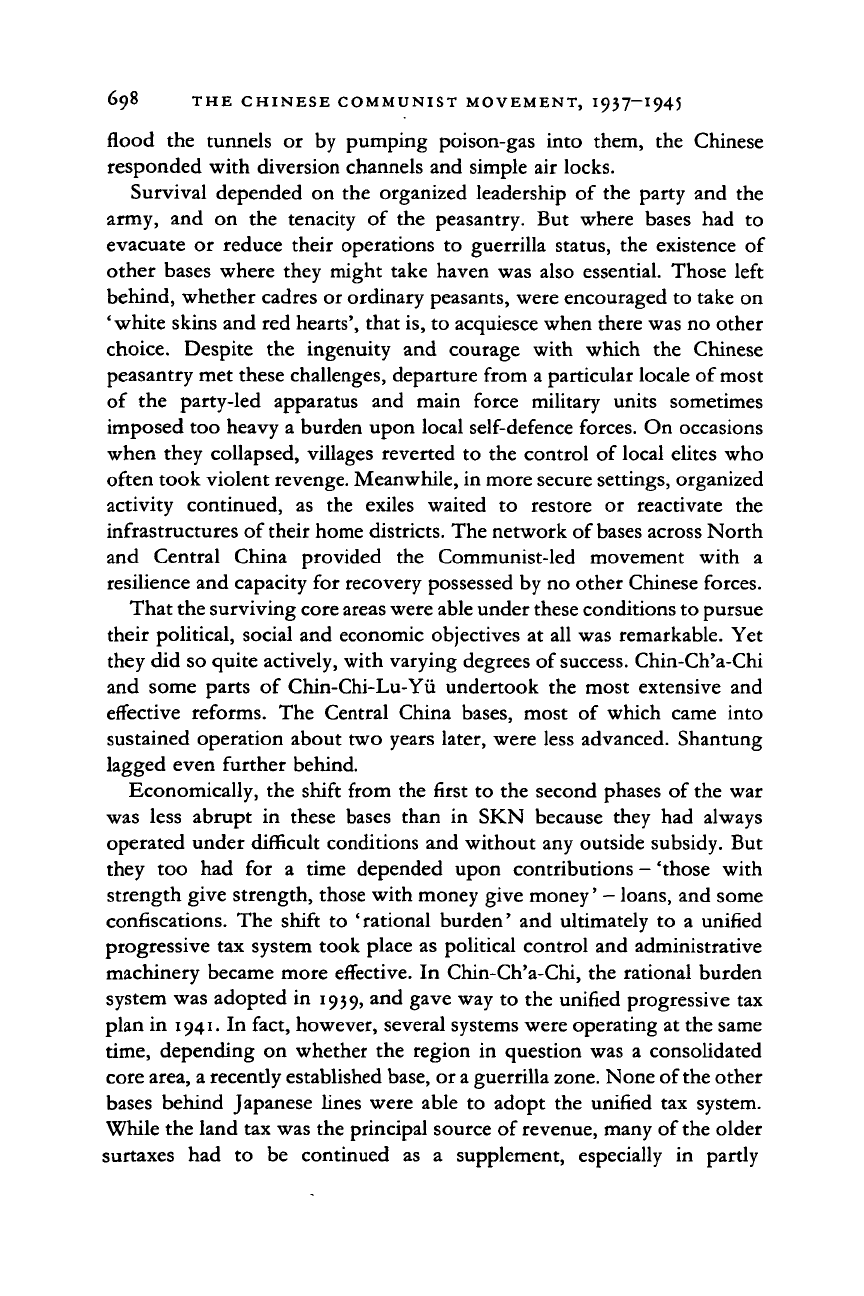
698 THE CHINESE COMMUNIST MOVEMENT, 1937-1945
flood the tunnels or by pumping poison-gas into them, the Chinese
responded with diversion channels and simple air locks.
Survival depended on the organized leadership of the party and the
army, and on the tenacity of the peasantry. But where bases had to
evacuate or reduce their operations to guerrilla status, the existence of
other bases where they might take haven was also essential. Those left
behind, whether cadres or ordinary peasants, were encouraged to take on
' white skins and red hearts', that is, to acquiesce when there was no other
choice. Despite the ingenuity and courage with which the Chinese
peasantry met these challenges, departure from a particular locale of most
of the party-led apparatus and main force military units sometimes
imposed too heavy a burden upon local self-defence forces. On occasions
when they collapsed, villages reverted to the control of local elites who
often took violent revenge. Meanwhile, in more secure settings, organized
activity continued, as the exiles waited to restore or reactivate the
infrastructures of their home districts. The network of bases across North
and Central China provided the Communist-led movement with a
resilience and capacity for recovery possessed by no other Chinese forces.
That the surviving core areas were able under these conditions to pursue
their political, social and economic objectives at all was remarkable. Yet
they did so quite actively, with varying degrees of
success.
Chin-Ch'a-Chi
and some parts of Chin-Chi-Lu-Yii undertook the most extensive and
effective reforms. The Central China bases, most of which came into
sustained operation about two years later, were less advanced. Shantung
lagged even further behind.
Economically, the shift from the first to the second phases of the war
was less abrupt in these bases than in SKN because they had always
operated under difficult conditions and without any outside subsidy. But
they too had for a time depended upon contributions - 'those with
strength give strength, those with money give money' - loans, and some
confiscations. The shift to 'rational burden' and ultimately to a unified
progressive tax system took place as political control and administrative
machinery became more effective. In Chin-Ch'a-Chi, the rational burden
system was adopted in 1939, and gave way to the unified progressive tax
plan in 1941. In fact, however, several systems were operating at the same
time,
depending on whether the region in question was a consolidated
core area, a recently established base, or
a
guerrilla zone. None of the other
bases behind Japanese lines were able to adopt the unified tax system.
While the land tax was the principal source of revenue, many of the older
surtaxes had to be continued as a supplement, especially in partly
Cambridge Histories Online © Cambridge University Press, 2008
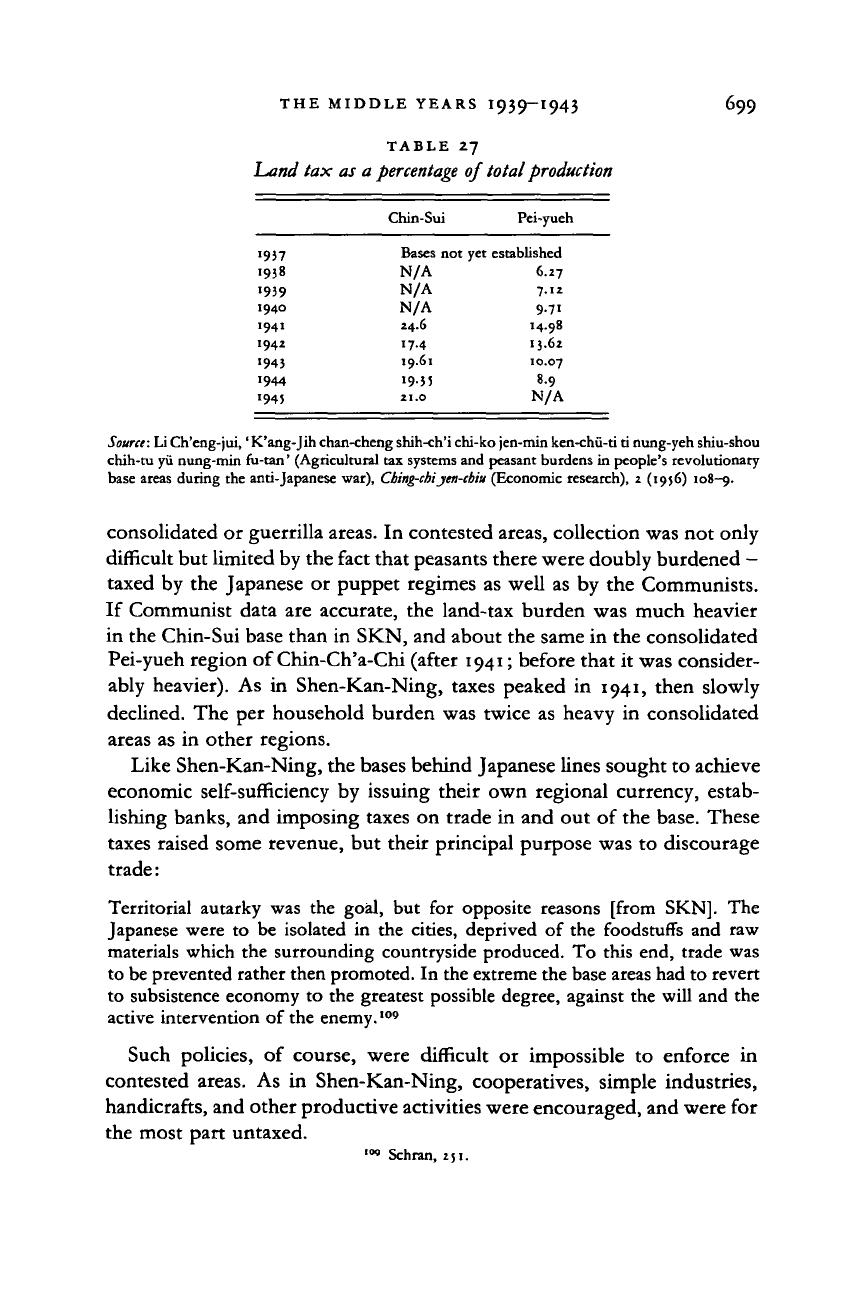
THE MIDDLE YEARS I939—1943 699
TABLE 27
Land tax as a
percentage
of total production
Chin-Sui Pei-yueh
1957 Bases
not yet
established
1938
N/A 6.27
1939
N/A 7.12
1940
N/A 9.71
1941
24.6 14-98
1942
17.4 13.62
1943
19.61 10.07
1944
19.35 8.9
1945
21.0 N/A
Source:
Li
Ch'eng-jui,'
K'ang-Jih
chan-cheng shih-ch'i chi-ko jen-min ken-chu-ti
ti
nung-yeh shiu-shou
chih-tu
yii
nung-min
fu-tan'
(Agricultural
tax
systems
and
peasant burdens
in
people's revolutionary
base areas during
the
anti-Japanese
war),
Cbing-cbiyen-cbiu (Economic
research),
2
(1956)
108-9.
consolidated or guerrilla areas. In contested areas, collection was not only
difficult but limited by the fact that peasants there were doubly burdened -
taxed by the Japanese or puppet regimes as well as by the Communists.
If Communist data are accurate, the land-tax burden was much heavier
in the Chin-Sui base than in SKN, and about the same in the consolidated
Pei-yueh region of Chin-Ch'a-Chi (after 1941; before that it was consider-
ably heavier). As in Shen-Kan-Ning, taxes peaked in 1941, then slowly
declined. The per household burden was twice as heavy in consolidated
areas as in other regions.
Like Shen-Kan-Ning, the bases behind Japanese lines sought to achieve
economic self-sufficiency by issuing their own regional currency, estab-
lishing banks, and imposing taxes on trade in and out of the base. These
taxes raised some revenue, but their principal purpose was to discourage
trade:
Territorial autarky was the goal, but for opposite reasons [from SKN]. The
Japanese were to be isolated in the cities, deprived of the foodstuffs and raw
materials which the surrounding countryside produced. To this end, trade was
to be prevented rather then promoted. In the extreme the base areas had to revert
to subsistence economy to the greatest possible degree, against the will and the
active intervention of the enemy.
109
Such policies, of course, were difficult or impossible to enforce in
contested areas. As in Shen-Kan-Ning, cooperatives, simple industries,
handicrafts, and other productive activities were encouraged, and were for
the most part untaxed.
'« Schran, 251.
Cambridge Histories Online © Cambridge University Press, 2008
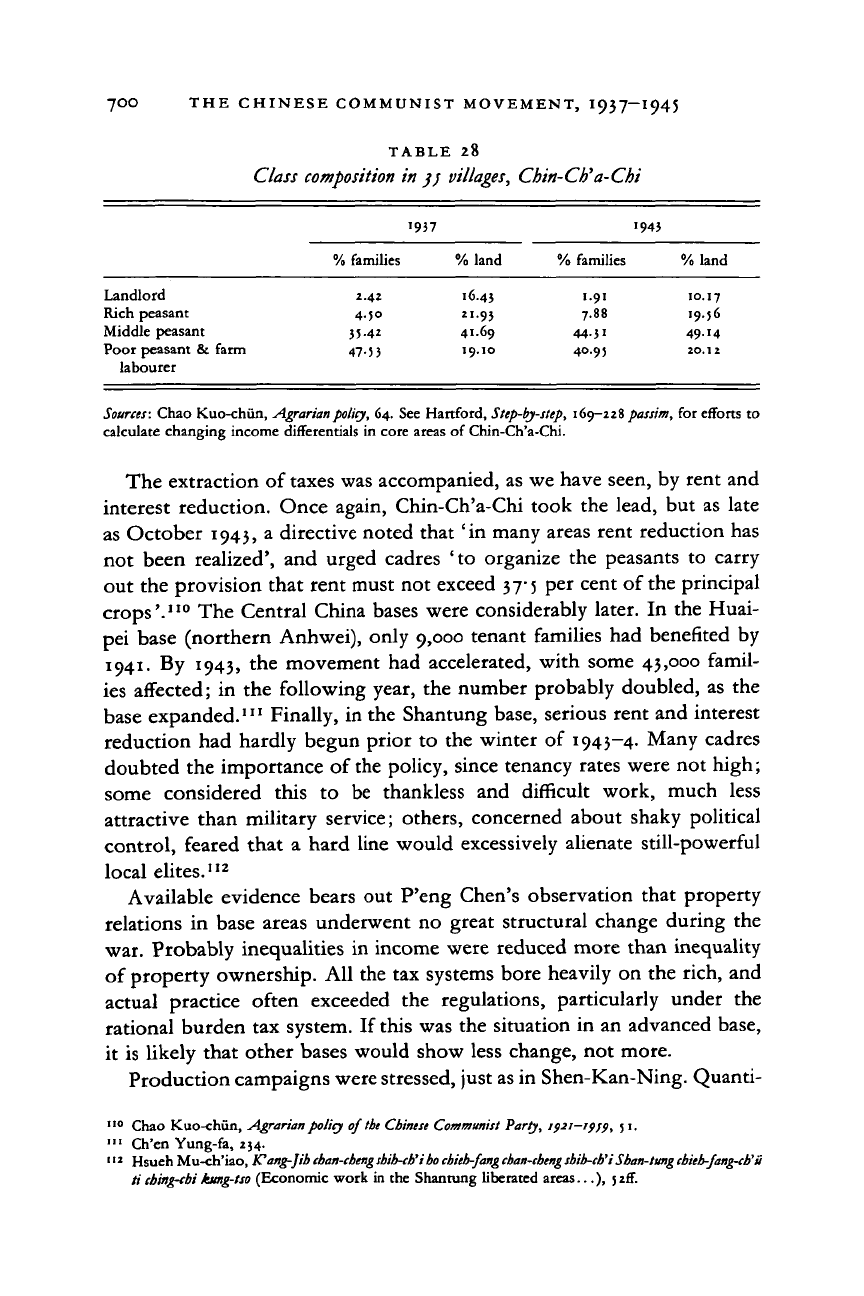
700 THE CHINESE COMMUNIST MOVEMENT, 1937-1945
TABLE 28
Class
composition
in $)
villages,
Chin-Cb'a-Chi
1937
1943
% families % land
%
families % land
Landlord
2.42 16.43 '-9
1
10.17
Rich peasant
4.50 21.93 7"
")•)(>
Middle peasant 3542
41-69 4431
49-
• 4
Poor peasant & farm
47.j
j
19.10 40.9) 20.12
labourer
Sources:
Chao Kuo-chiin, Agrarian
policy,
64. See Hartford,
Step-by-step,
169-228
passim,
for efforts
to
calculate changing income differentials in core areas of Chin-Ch'a-Chi.
The extraction of taxes was accompanied, as we have seen, by rent and
interest reduction. Once again, Chin-Ch'a-Chi took the lead, but as late
as October 1943, a directive noted that 'in many areas rent reduction has
not been realized', and urged cadres
'to
organize the peasants
to
carry
out the provision that rent must not exceed 37-5 per cent of the principal
crops'.
110
The Central China bases were considerably later.
In
the Huai-
pei base (northern Anhwei), only 9,000 tenant families had benefited by
1941.
By 1943, the movement had accelerated, with some 43,000 famil-
ies affected;
in
the following year, the number probably doubled, as the
base expanded.
111
Finally, in the Shantung base, serious rent and interest
reduction had hardly begun prior to the winter
of
1943-4. Many cadres
doubted the importance of the policy, since tenancy rates were not high;
some considered this
to be
thankless
and
difficult work, much less
attractive than military service; others, concerned about shaky political
control, feared that
a
hard line would excessively alienate still-powerful
local elites.
112
Available evidence bears out P'eng Chen's observation that property
relations
in
base areas underwent no great structural change during the
war. Probably inequalities in income were reduced more than inequality
of property ownership. All the tax systems bore heavily on the rich, and
actual practice often exceeded
the
regulations, particularly under
the
rational burden tax system. If this was the situation in an advanced base,
it is likely that other bases would show less change, not more.
Production campaigns were stressed, just as in Shen-Kan-Ning. Quanti-
1
Io
Chao Kuo-chun, Agrarian
policy
of
the Chinese Communist
Party,
ipif-ifjp, ;
i.
111
Ch'en Yung-fa, 234.
112
Hsueh
Mu-ch'iao,
Kong-Jib cban-cbeng sbib-cb'i bo cbitb-fang cban-cbeng sbib-cb'i Sban-tung cbieb-fang-cb'S
ti
cbing-cbi ksmg-tso
(Economic work in the Shantung liberated areas...),
5
2C
Cambridge Histories Online © Cambridge University Press, 2008
